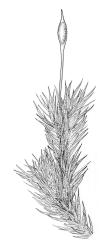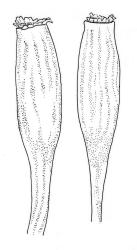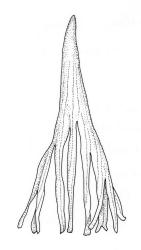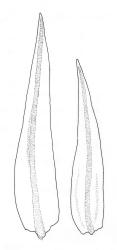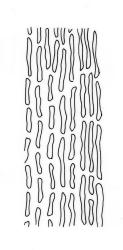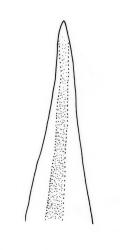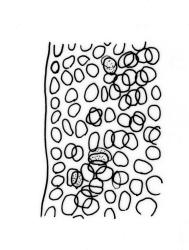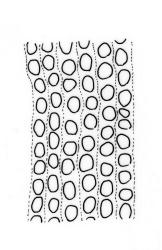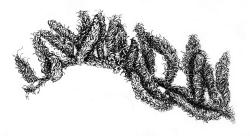- ≡ Orthotrichum longirostre Hook., Musci Exot. 1, 25 (1818) – as longirostrum
- = Orthotrichum acutifolium Hook. & Grev., Edinburgh J. Sci. 1: 118 (1824)
- ≡ Macromitrium acutifolium (Hook. & Grev.) Brid., Bryol. Univ. 1, 735 (1826)
- ≡ Macromitrium longirostre var. acutifolium (Hook. & Grev.) Hook.f. & Wilson in Wilson, Bot. Antarct. Voy. II (Fl. Nov.-Zel.) Part II, 78 (1854)
Plants variable in size, small to robust, lustrous or dull, light olive-green, yellow-green or rich green above, darker or chestnut-brown below. Branches mostly 3–12 mm, but sometimes to c. 35 mm, ascendant, often forked below perichaetia. Stem leaves erect-flexuose when dry, erect-spreading when moist, lanceolate or ovate-lanceolate, gradually tapered to narrowly acuminate apices, c. 1.0–2.0 mm. Branch leaves loosely or tightly spiralled around the branch and with upper portions reflexed when dry, erect-spreading and straight or weakly flexuose when moist, not funiculate, narrowly to ovate-lanceolate or oblong, variable at apex, narrowly acuminate, long-cuspidate, or broadly acute, keeled throughout or ± flattened at apex, (1.6–)2.3–4.0 mm; margins entire, plane above, plane or recurved on one side at mid leaf when dry, less conspicuously recurved when moist; upper laminal cells rounded-quadrate to oblong-elliptic (a few sometimes oblate), thick-walled, bulging or plane, smooth, usually bistratose in patches in upper third of lamina, less often bistratose only at extreme apex, 5–12(–16) × 4–10 μm (lumina 3–5 μm wide), often smaller at margins; mid laminal cells differing little from upper, in ± distinct longitudinal rows, c. 10–15 × 8–10 μm; inner basal cells highly variable in shape and length (sometimes variable in a single plant) ± elongate-rectangular or rounded-subquadrate to elliptic, very thick-walled and evenly or irregularly thickened, mostly 9–40 × 8–10 μm, with lumina mostly 5–8 μm wide, sometimes more irregular near costa; marginal basal cells not forming a distinct border. Costa ending a few cells below the leaf apex to excurrent as a narrow cusp, the abaxial superficial cells elongate except at extreme tip where covered by ± quadrate cells, in mid leaf cross-section with 1–2 rows of guide cells, 2–3(–4) abaxial rows of stereids, and 1–2 rows of adaxial stereids. Gemmae absent.
Dioicous. Perichaetial leaves similar or smaller than vegetative leaves, ovate, acute. Perigonia bulbiform, terminal on branches, c. 0.8 mm diam., the inner bracts lingulate, c. 1.5 mm. Setae 2.5–8(–11) mm, smooth, straight or slightly flexuose, very thick, dextrorse; capsules narrowly ovate or fusiform-cylindric, not strongly constricted at mouth, moderately ribbed or rarely smooth for entire length when dry, yellow-brown to dark red-brown, (1.0–)1.5–2.9(–3.5) mm; exothecial cells thick-walled (more strongly so on ribs), elongate-sinuose to elliptic, variable in length but mostly 40–60 μm, becoming round-oblate near mouth; stomata and annulus as per genus; operculum 1–1.5 mm. Peristome double; exostome teeth 16, pale, erect-recurved when dry, incurved when moist, irregular and often broken, blunt, coarsely papillose, often very thick outwardly and ± smooth below, often absent in older capsules; endostome an irregular, papillose membrane 1–3 cells high. Calyptra deeply lacerate, strongly plicate, naked. Spores isosporous, (20–)25–38 μm, papillose, thick-walled.
| Category | Number |
|---|---|
| Indigenous (Endemic) | 1 |
| Indigenous (Non-endemic) | 1 |
| Total | 2 |
Macromitrium longirostre is treated here in a broader sense than by Vitt (1983), with M. ramsayae Vitt reduced to varietal rank within it. While the more extreme Chatham Is populations can be distinguished into two groups using Vitt’s criteria (and the criteria used in the above key to species), at least six of the 18 collections in CHR are intermediate by some of these criteria. Given the high number of morphological intermediates and overlapping geographic ranges, varietal rank is appropriate. As conceived here, the var. ramsayae is characterised by having shorter branches (and hence a more compact habit) than var. longirostre, branch leaf apices usually broader and less cuspidate, costae more often subpercurrent, bistratose portions of the upper lamina restricted to the extreme distal portion of the leaf, shorter inner basal cells, shorter setae, and smaller spores.
South I. and Stewart I. populations of M. longirostre var. longirostre invariably have irregular and often extensive bistratose patches of cells in the upper third of the lamina, while Chatham Is. populations are more variable and intergrading.
Vitt & Ramsay’s (1985) "M. longirostre group" includes the present species, "M. ramsayae", and the N.Z. endemic M. retusum. The lack of fragile leaf tips and the gradually narrowed leaves distinguish both varieties of M. longirostre from M. retusum.
Distribution and ecology as for the varieties, which are keyed out above.



